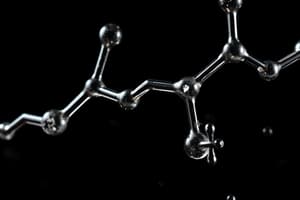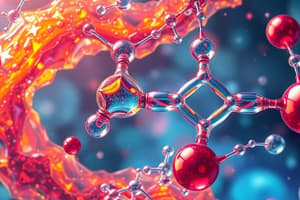Podcast
Questions and Answers
What stabilizes a molecule by delocalizing charge and electron density?
What stabilizes a molecule by delocalizing charge and electron density?
- Carbocation
- Enol
- Halogenation
- Resonance (correct)
How do halogens stabilize an adjacent positive charge?
How do halogens stabilize an adjacent positive charge?
- By steric hindrance
- Through inductive effects
- Through hyperconjugation
- By resonance (correct)
What is the product when one mole of X2 (X = Cl or Br) adds to an alkyne?
What is the product when one mole of X2 (X = Cl or Br) adds to an alkyne?
- Dihalide (correct)
- Trihalide
- Monoalkyl halide
- Tetrahalide
What happens when alkynes undergo hydration with concentrated acid?
What happens when alkynes undergo hydration with concentrated acid?
What is the main reason why equilibrium favors the keto form in tautomers?
What is the main reason why equilibrium favors the keto form in tautomers?
Which tautomer has a C=O and an additional C−H bond?
Which tautomer has a C=O and an additional C−H bond?
What is the purpose of the Hydroboration-Oxidation reaction sequence?
What is the purpose of the Hydroboration-Oxidation reaction sequence?
In Hydroboration-Oxidation, why does the hydroboration of a terminal alkyne result in an aldehyde?
In Hydroboration-Oxidation, why does the hydroboration of a terminal alkyne result in an aldehyde?
Which catalyst is used for the reduction of alkynes to alkanes?
Which catalyst is used for the reduction of alkynes to alkanes?
What happens when hydrogenation of alkynes is conducted with the Lindlar catalyst?
What happens when hydrogenation of alkynes is conducted with the Lindlar catalyst?
Which type of addition occurs in hydroboration−oxidation of a terminal alkyne?
Which type of addition occurs in hydroboration−oxidation of a terminal alkyne?
Why does the terminally located borane in hydroboration−oxidation add to the terminal carbon of an alkyne?
Why does the terminally located borane in hydroboration−oxidation add to the terminal carbon of an alkyne?
What is the main product formed when disubstituted alkynes react with potassium permanganate in mild conditions?
What is the main product formed when disubstituted alkynes react with potassium permanganate in mild conditions?
In the reaction of acetylide anions with alkyl halides, which type of alkyl halide yields the product of nucleophilic substitution the fastest?
In the reaction of acetylide anions with alkyl halides, which type of alkyl halide yields the product of nucleophilic substitution the fastest?
What is the mechanism involved when acetylide anions react with unhindered alkyl halides to yield products of nucleophilic substitution?
What is the mechanism involved when acetylide anions react with unhindered alkyl halides to yield products of nucleophilic substitution?
Steric hindrance around the leaving group causes which type of alkyl halides to preferentially undergo elimination by an E2 mechanism?
Steric hindrance around the leaving group causes which type of alkyl halides to preferentially undergo elimination by an E2 mechanism?
What type of reaction forms new carbon-carbon bonds in high yield only with unhindered CH3X and 1° alkyl halides when reacting with acetylide anions?
What type of reaction forms new carbon-carbon bonds in high yield only with unhindered CH3X and 1° alkyl halides when reacting with acetylide anions?
Ozonolysis of alkynes is used mainly for which purpose?
Ozonolysis of alkynes is used mainly for which purpose?
What is the primary purpose of retrosynthetic analysis in organic chemistry?
What is the primary purpose of retrosynthetic analysis in organic chemistry?
In retrosynthetic analysis, what does an open arrow (⇒) indicate?
In retrosynthetic analysis, what does an open arrow (⇒) indicate?
Which type of reactions are often categorized in retrosynthetic analysis?
Which type of reactions are often categorized in retrosynthetic analysis?
How is a carbonyl group typically formed in a retrosynthetic analysis?
How is a carbonyl group typically formed in a retrosynthetic analysis?
What is the source of the acetylide anion used to form new C-C bonds in retrosynthetic analysis?
What is the source of the acetylide anion used to form new C-C bonds in retrosynthetic analysis?
In retrosynthetic analysis, what role does functional group interconversion play?
In retrosynthetic analysis, what role does functional group interconversion play?
During retrosynthetic analysis, we work forwards from a desired product to determine the starting materials.
During retrosynthetic analysis, we work forwards from a desired product to determine the starting materials.
In retrosynthetic analysis, the product is drawn on the left and the starting material on the right using an open arrow (⇒).
In retrosynthetic analysis, the product is drawn on the left and the starting material on the right using an open arrow (⇒).
Functional group interconversions play a crucial role in designing a synthesis process.
Functional group interconversions play a crucial role in designing a synthesis process.
Acetylene is used to prepare the acetylide anion by treatment with an acid.
Acetylene is used to prepare the acetylide anion by treatment with an acid.
Retrosynthetic analysis often categorizes reactions into those that form new carbon-oxygen bonds and those that convert one functional group into another.
Retrosynthetic analysis often categorizes reactions into those that form new carbon-oxygen bonds and those that convert one functional group into another.
Hydration of a triple bond leads to the formation of an alcohol group.
Hydration of a triple bond leads to the formation of an alcohol group.
Steric hindrance around the leaving group causes primary alkyl halides to preferentially undergo elimination by an E1 mechanism.
Steric hindrance around the leaving group causes primary alkyl halides to preferentially undergo elimination by an E1 mechanism.
Retrosynthetic analysis focuses on working backwards from a target compound to determine the starting materials.
Retrosynthetic analysis focuses on working backwards from a target compound to determine the starting materials.
In retrosynthetic analysis, acetylide anions are used to form new carbon-nitrogen bonds.
In retrosynthetic analysis, acetylide anions are used to form new carbon-nitrogen bonds.
The synthesis process involves working from a desired product to identify potential intermediates.
The synthesis process involves working from a desired product to identify potential intermediates.
Flashcards are hidden until you start studying




